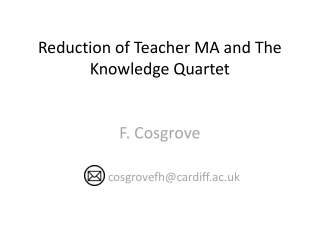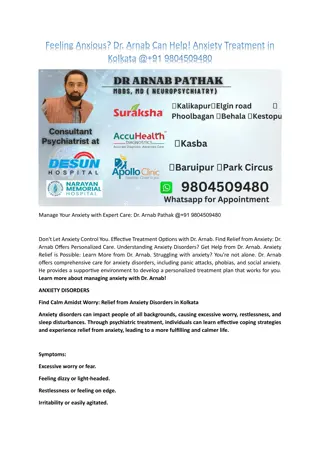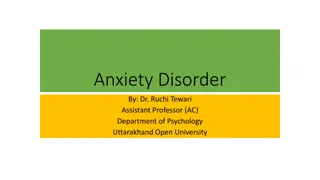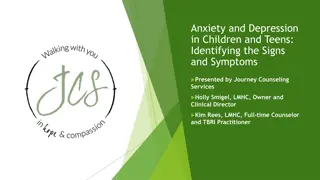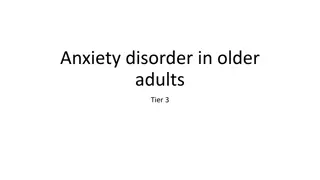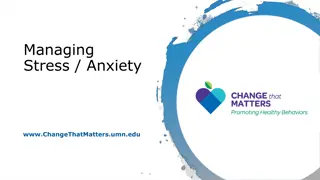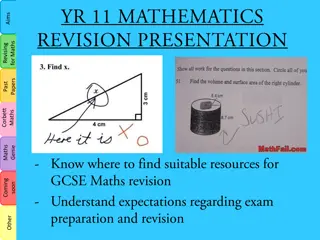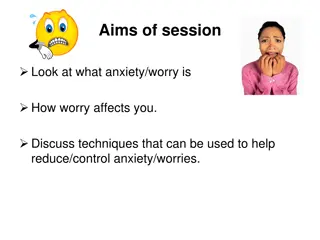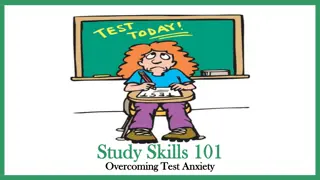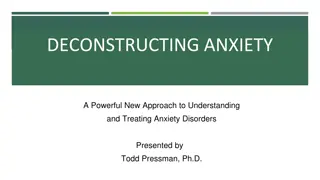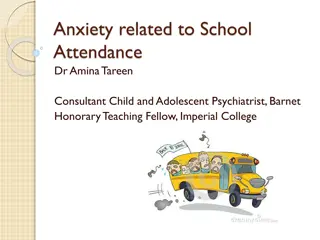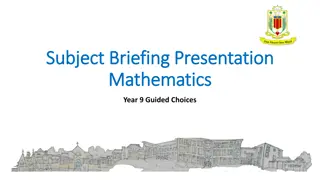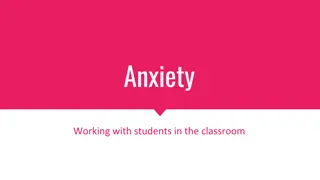Understanding and Addressing Maths Anxiety in Students
Maths anxiety, characterized by negative attitudes, avoidance, and impact on performance, is a prevalent issue affecting learners worldwide. This session aims to delve into the causes and implications of maths anxiety, highlighting the importance of adopting a positive psychology approach rooted in resilience. By examining personal experiences and reflecting on teaching methods, strategies can be developed to combat maths anxiety and promote a supportive learning environment for students.
Download Presentation

Please find below an Image/Link to download the presentation.
The content on the website is provided AS IS for your information and personal use only. It may not be sold, licensed, or shared on other websites without obtaining consent from the author. Download presentation by click this link. If you encounter any issues during the download, it is possible that the publisher has removed the file from their server.
E N D
Presentation Transcript
Maths Anxiety something must be done Sue Johnston-Wilder
Aims of this session To understand why maths anxiety is so prevalent To begin to understand what we can do about it, for ourselves and our students To take an approach rooted in positive psychology: resilience To introduce a 3- level model for staff CPD
What is maths anxiety A feeling of tension, apprehension, or fear that interferes with maths performance (Ashcraft, 2002) Results in: Negative attitudes & motivation towards maths Avoidance Lower grades Negative self-perceptions Impact on working memory http://www.mccc.edu/~jenningh/Courses/documents/math_anxiety.pdf
Maths anxiety ... interferes with the process of doing maths affects learners, parents, teachers contagious prevalence across the world? impact? including avoidance often ignored or dismissed
The problem Learners are naturally curious Fear is learned Things that cause fear become avoided Vicious cycle Combined with fixed mindsets: I am not a maths person Self-fulfilling prophecy
Maths teaching A.L.I.V.E. maths T.R.I.E.D. maths Accessible Linked Inclusive Values-based Engaging Tedious Rote Isolated Elitist De-personalised (adapted from Nardi & Steward, 2003) (Johnston-Wilder et al, 2015)
Thinking of maths anxiety through the lens of trauma and adverse experience
Reflecting on experiences Think about your personal experiences of maths learning positive experiences and negative experiences.
Student adverse prior experience [the teacher] would make you stand in front of everyone, and then she would just be, like, You re not good, you don t understand, you re stupid. (Halima) I always felt like I was stupid Starting maths this year it still gives me chills Cos even now, you know, that fear of saying Oh I don t get it! I still don t get it! is still there. (Nina) Molly s father would grasp her neck in frustration when she didn t get it.
The maths monster The expression maths monster arose at the end of a course for staff at University of Warwick who self-identified as maths anxious: Thank you for rescuing me from the maths monster.
Maths anxiety ...is like an invisible monster, a grim reality for a significant proportion of learners is acquired ...is disabling ...has been written about since 1950s ...now affects large numbers of people ...causes reduced or backwards progression ...can be addressed
It is not just behaviour it is managing fear, it is managing a very deep sense of failure, being rubbish . In the early stages [of teaching] it s 90% psychology and only 10% maths (Quotations from maths teachers: ETF (2014) Effective Practices in Post-16 Vocational Maths )
Some brain facts for maths teachers As a survival strategy, the brain seeks to distinguish challenge from threat to well-being or survival Includes physical and social threats, such as being left behind or humiliated or shouted at Previous threats are remembered When the brain (sub-consciously) perceives a threat, it initially responds by fight or flight mode
Mathematical Resilience a learner s stance towards mathematics that enables pupils to continue learning despite finding setbacks and challenges in their mathematical learning journey (Johnston-Wilder & Lee, 2010, p. 38).
Learning requires psychological safety Relatedness Autonomy Competence including competence to self-safeguard (Ryan and Deci, 2017)
Competence to self-safeguard can be achieved using three tools: growth zone model hand model of brain triggering relaxation response Shared between teacher, supporter and students, the tools help improve dialogue, awareness, and apt responses to reduce maths anxiety.
A toolkit for promoting mathematical resilience
Mathematical resilience MR understanding of the emotional response to threat (the hand model) Specific tools to manage (breathing response) and reinterpret experience (the growth zone model) Specific tools to thrive in the growth zone
The hand model of the brain (Dan Siegel)
The hand model of the brain Key message: the brain can t panic and think effectively at the same time Dan Siegel explaining his model: https://www.youtube.com/watch?v=gm9CIJ74Oxw Maths resilience version: https://www.youtube.com/watch?v=7zW8w9kuu6E&t =7s
The relaxation response counters the stress (or fight or flight ) response. by slowing breathing rate, relaxing muscles, and reducing blood pressure Herbert Benson 2000
The growth zone model Fight or flight mode
The growth zone model It turns out, this is not new but re-packaged thinking:
The growth zone model Accept feeling of stupidity in red zone as temporary How to get out of the red zone? Building experience of being in and extending the orange zone Encouraging learners to come out of comfort.
The growth zone model: green zone Cruising in the comfort zone can build self-confidence and confidence in the teacher & provide opportunities for practice & automaticity.
The growth zone model: red zone The danger zone is where what is being asked is not within the learner s reach yet, even with support, and mathematical well-being is under threat. Stress increases, possibly to panic; little or no useful learning takes place.
Not stupid but panicking Panic is temporary To build resilience, learners need to understand this state is temporary (Seligman).
The growth zone model: amber zone New learning happens in the growth zone where learners experience challenge with sufficient safe-guarding it should be safe enough to make mistakes, get stuck, require support, find activities tiring.
The growth zone includes growth mindset (Dweck, 2006) struggle (persistence and perseverance) (Seligman and Williams) value and autonomous motivation (Ryan & Deci, 2017) support and relatedness (being enabled to recruit)
The blue zone for completeness
Getting out of the red zone Relaxation response (Benson 2000) Rest and digest 5/7 breathing Focus on 5 things you can hear Go for a walk Micro-mindfulness Don t try to do maths whilst your brain is focused on the maths monster !
Building the amber/growth zone Ask questions Try a simpler example Support each other Recruit help Use the Internet Expect to get stuck Expect to make mistakes Use rough work Take time ...
The growth zone model a means to help learners understand and articulate their feelings when they are learning maths... a means to safeguard the mathematical wellbeing of those involved in learning or supporting maths
Tools in practice Building a shared language for mathematical safeguarding Red means stop talking and listen! This practice takes a while to develop as a teacher! Some teachers give each learner a copy of the GZM to use with a coin Some teachers give learners opportunity to write their own words for the feelings in each zone How would you use the tools in your own practice?
The ladder model a 4thtool I need another rung
The 3 level model for CPD Based on Homes & Grandison (2021)
1 Anxiety aware practice Increase awareness of anxiety, how to recognise MA in learners and how to resist causing further harm Based on Homes & Grandison (2021)
2 Anxiety-informed practice Increase awareness of anxiety, how to recognise MA in learners and how to resist causing further harm; Establish a safer teaching environment, promoting MR and enhancing progress in mathematics. Based on Homes & Grandison (2021)
Trauma-informed practice Safety Trust Choice Collaboration Empowerment Homes & Grandison (2021)
Self-efficacy and resilience Mathematical resilience (MR) maintaining self-efficacy in the face of personal or social threat to mathematical well-being (Johnston- Wilder & Lee, 2010)
Sources of self-efficacy Bandura (1997) proposed four sources of self-efficacy (and in-efficacy): o mastery experiences o vicarious experiences o verbal persuasion o physiological and affective states.
Autonomous motivation Personal value of maths, growth mindset, community align with SDT needs for autonomy, competence and relatedness
Development of a research area Conversations about mathematics anxiety and psychological resilience started in 2008 Starting to write about mathematical resilience Working on mathematical resilience framework with teachers, students, parents, support staff, and with psychologists working on maths anxiety
Coaching for Mathematical Resilience course 24 hour course Accredited by ASDAN Evidence of efficacy Dual led Expensive
Coaching for Mathematical Resilience for individuals one-to-one coaching involves older learner, support staff or parent Goodall, J. and Johnston-Wilder, S. (2015) Overcoming Mathematical Helplessness and Developing Mathematical Resilience in Parents: An Illustrative Case Study. Creative Education, 6, 526-535. doi: 10.4236/ce.2015.65052. Johnston-Wilder, S. , Lee, C. and Mackrell, K. (2021) Addressing Mathematics Anxiety through Developing Resilience: Building on Self-Determination Theory. Creative Education, 12, 2098-2115. doi: 10.4236/ce.2021.129161.
Supporting teachers with practitioner research


